Unit 2 Success Lesson 1 Money vs Success(Grammar)课件(共38张PPT)北师大版(2019)选择性必修第一册
文档属性
| 名称 | Unit 2 Success Lesson 1 Money vs Success(Grammar)课件(共38张PPT)北师大版(2019)选择性必修第一册 | 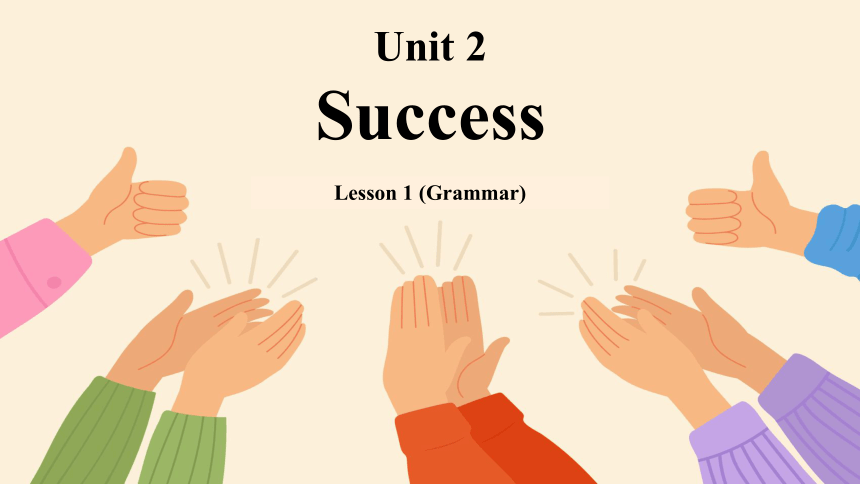 | |
| 格式 | pptx | ||
| 文件大小 | 23.6MB | ||
| 资源类型 | 教案 | ||
| 版本资源 | 北师大版(2019) | ||
| 科目 | 英语 | ||
| 更新时间 | 2025-07-31 21:32:37 | ||
图片预览

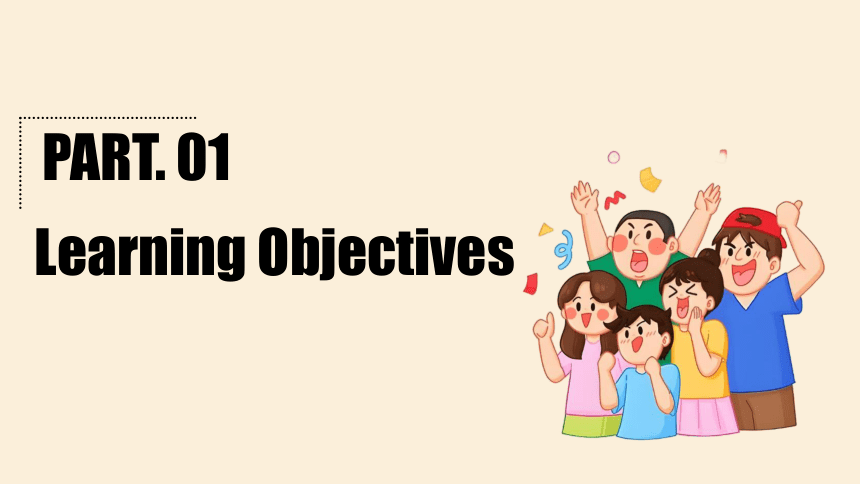
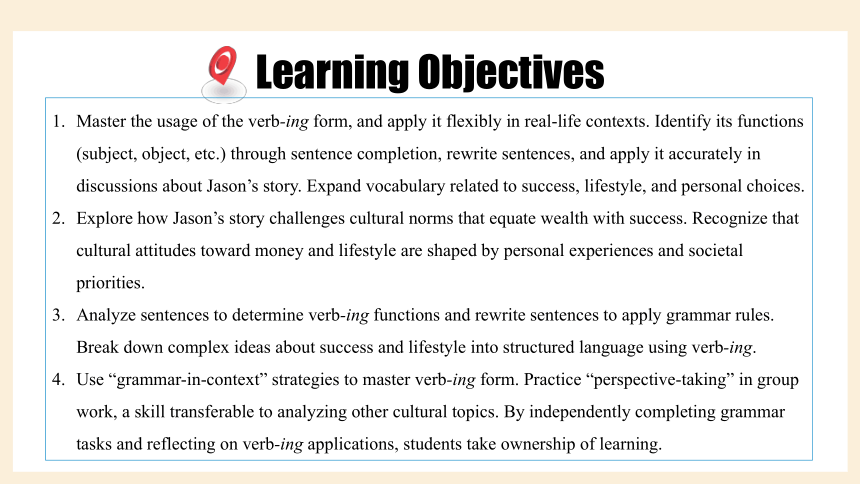
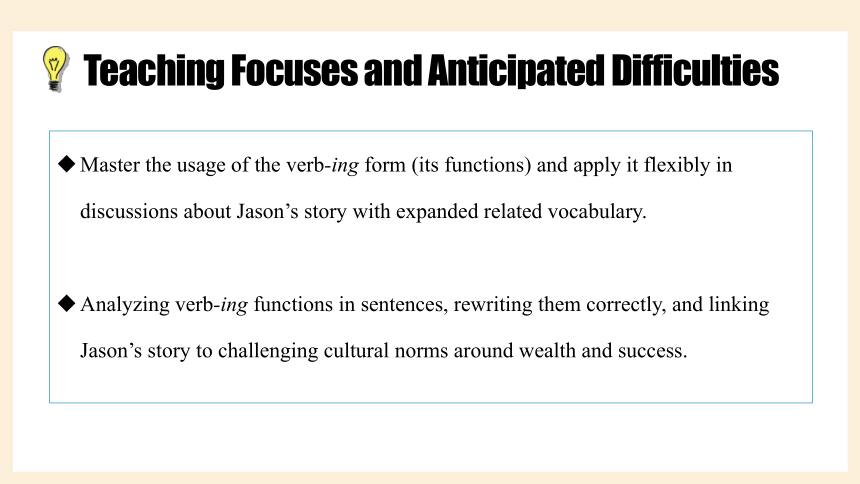

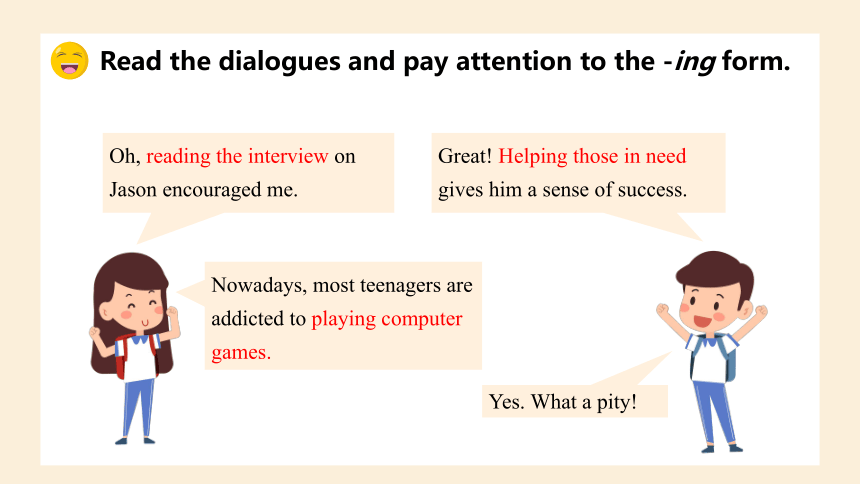
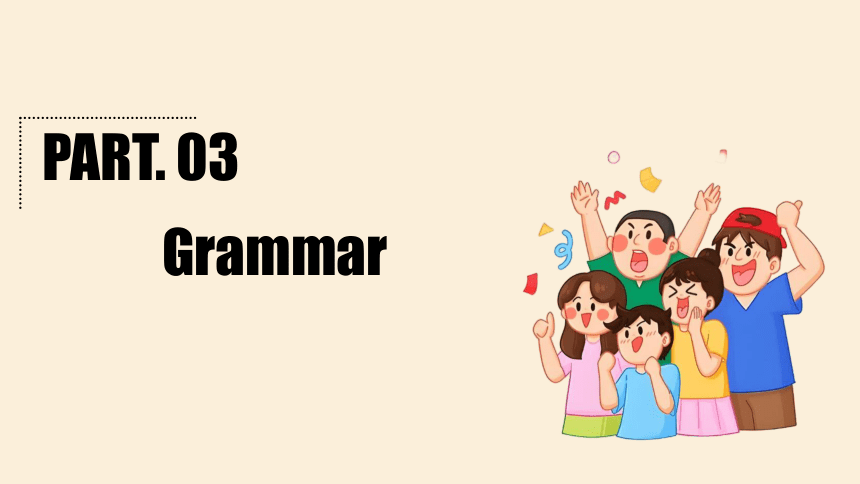
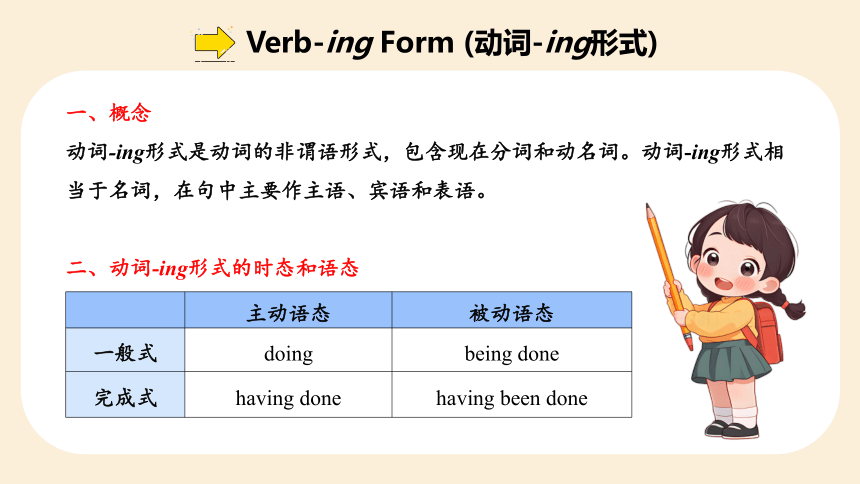
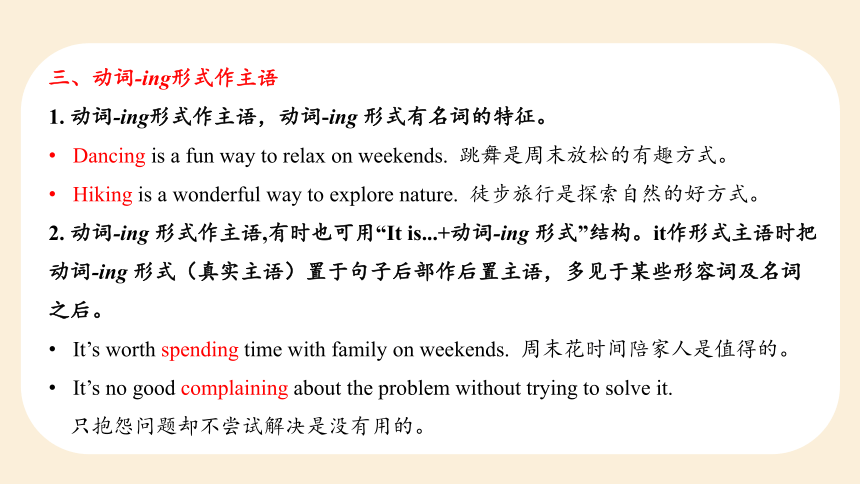
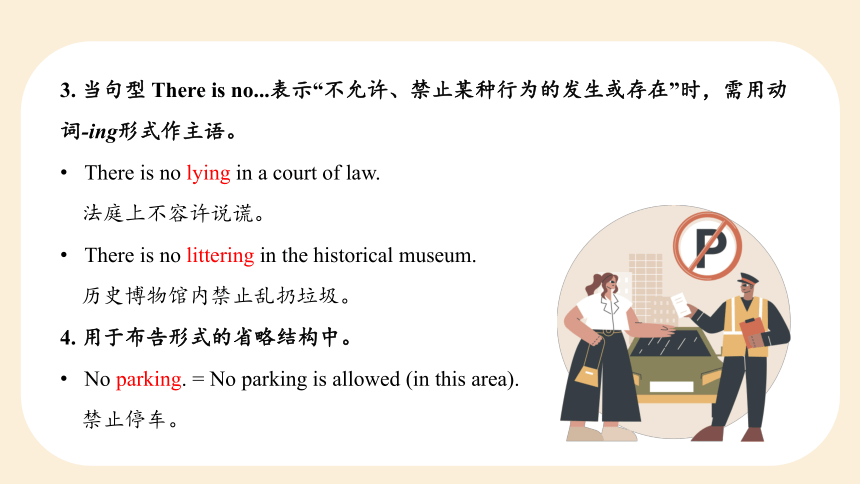
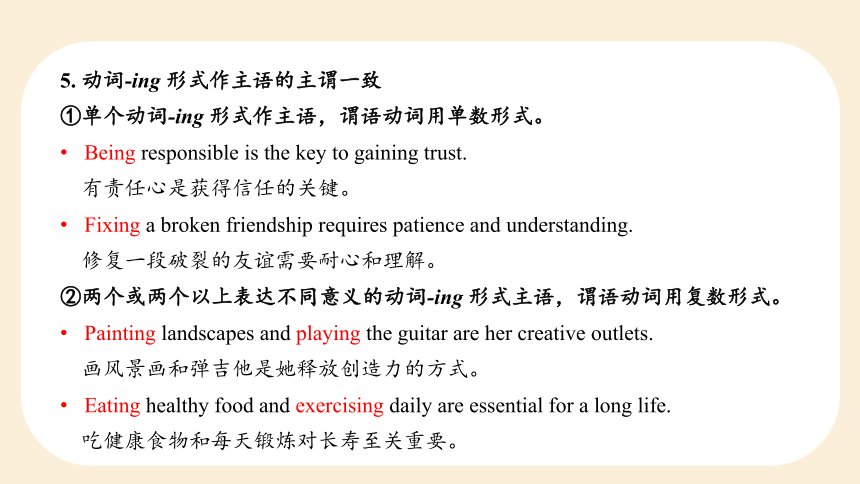
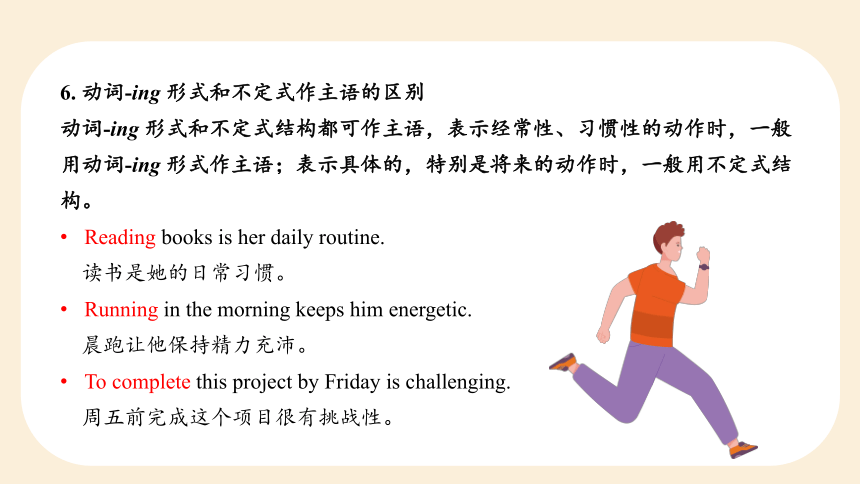
文档简介
(共38张PPT)
Unit 2
Success
Lesson 1 (Grammar)
Learning Objectives
PART. 01
Understand the daily study and life of British middle school students by watching videos. Based on your own daily study and life, compare the study and life in Chinese and British schools, and find out the similarities and differences between the two. Talk about your first impression of high school life, and have a preliminary perception of the study and life in the senior high school stage.
Learning Objectives
Master the usage of the verb-ing form, and apply it flexibly in real-life contexts. Identify its functions (subject, object, etc.) through sentence completion, rewrite sentences, and apply it accurately in discussions about Jason’s story. Expand vocabulary related to success, lifestyle, and personal choices.
Explore how Jason’s story challenges cultural norms that equate wealth with success. Recognize that cultural attitudes toward money and lifestyle are shaped by personal experiences and societal priorities.
Analyze sentences to determine verb-ing functions and rewrite sentences to apply grammar rules. Break down complex ideas about success and lifestyle into structured language using verb-ing.
Use “grammar-in-context” strategies to master verb-ing form. Practice “perspective-taking” in group work, a skill transferable to analyzing other cultural topics. By independently completing grammar tasks and reflecting on verb-ing applications, students take ownership of learning.
Understand the daily study and life of British middle school students by watching videos. Based on your own daily study and life, compare the study and life in Chinese and British schools, and find out the similarities and differences between the two. Talk about your first impression of high school life, and have a preliminary perception of the study and life in the senior high school stage.
Teaching Focuses and Anticipated Difficulties
Master the usage of the verb-ing form (its functions) and apply it flexibly in discussions about Jason’s story with expanded related vocabulary.
Analyzing verb-ing functions in sentences, rewriting them correctly, and linking Jason’s story to challenging cultural norms around wealth and success.
Lead-in
PART. 02
Read the dialogues and pay attention to the -ing form.
Oh, reading the interview on Jason encouraged me.
Great! Helping those in need gives him a sense of success.
Nowadays, most teenagers are addicted to playing computer games.
Yes. What a pity!
Grammar
PART. 03
Verb-ing Form (动词-ing形式)
一、概念
动词-ing形式是动词的非谓语形式,包含现在分词和动名词。动词-ing形式相当于名词,在句中主要作主语、宾语和表语。
二、动词-ing形式的时态和语态
主动语态 被动语态
一般式 doing being done
完成式 having done having been done
三、动词-ing形式作主语
1. 动词-ing形式作主语,动词-ing 形式有名词的特征。
Dancing is a fun way to relax on weekends. 跳舞是周末放松的有趣方式。
Hiking is a wonderful way to explore nature. 徒步旅行是探索自然的好方式。
2. 动词-ing 形式作主语,有时也可用“It is...+动词-ing 形式”结构。it作形式主语时把动词-ing 形式(真实主语)置于句子后部作后置主语,多见于某些形容词及名词之后。
It’s worth spending time with family on weekends. 周末花时间陪家人是值得的。
It’s no good complaining about the problem without trying to solve it.
只抱怨问题却不尝试解决是没有用的。
3. 当句型 There is no...表示“不允许、禁止某种行为的发生或存在”时,需用动词-ing形式作主语。
There is no lying in a court of law.
法庭上不容许说谎。
There is no littering in the historical museum.
历史博物馆内禁止乱扔垃圾。
4. 用于布告形式的省略结构中。
No parking. = No parking is allowed (in this area).
禁止停车。
5. 动词-ing 形式作主语的主谓一致
①单个动词-ing 形式作主语,谓语动词用单数形式。
Being responsible is the key to gaining trust.
有责任心是获得信任的关键。
Fixing a broken friendship requires patience and understanding.
修复一段破裂的友谊需要耐心和理解。
②两个或两个以上表达不同意义的动词-ing 形式主语,谓语动词用复数形式。
Painting landscapes and playing the guitar are her creative outlets.
画风景画和弹吉他是她释放创造力的方式。
Eating healthy food and exercising daily are essential for a long life.
吃健康食物和每天锻炼对长寿至关重要。
6. 动词-ing 形式和不定式作主语的区别
动词-ing 形式和不定式结构都可作主语,表示经常性、习惯性的动作时,一般用动词-ing 形式作主语;表示具体的,特别是将来的动作时,一般用不定式结构。
Reading books is her daily routine.
读书是她的日常习惯。
Running in the morning keeps him energetic.
晨跑让他保持精力充沛。
To complete this project by Friday is challenging.
周五前完成这个项目很有挑战性。
四、动词-ing形式作宾语
1. 只可使用-ing形式作宾语的动词有:
suggest、finish、practise、avoid、miss、delay、like、 enjoy、imagine、deny、admit、consider、escape、risk、mind 等。
2. 只接-ing形式的短语有:
be used to、can’t stand、give up、feel like、keep、on、insist on、look forward to、put off、devote to、stick to、object to、be busy、get down to等。
He imagines becoming a famous artist one day.
他想象自己某天成为知名艺术家。
They can’t stand waiting in long lines.
他们受不了排长队。
后接-ing形式的动词和动词短语:
喜欢考虑逃避免 (enjoy, consider, escape, avoid)
停止放弃太冒险 (stop, give up, risk)
介意想象莫推延 (mind, imagine, put off, delay)
要求完成是期盼 (require, finish, look forward to)
建议继续勤练习 (suggest, go on, practise)
不禁原谅要坚持 (can't help, excuse, insist on)
继续介意成功来 (keep on, mind, succeed in)
口诀助记
3. 既可接-ing 形式,又可接 to-infinitive 作宾语的动词有:
start、begin、continue、like、love、hate 等,意思基本没有区别。
love、like和 hate 接动名词表示长久的规律性的好恶;接不定式表示一时的、个别性的好恶。
He continued working/to work on the project despite the heavy rain.
尽管下着大雨,他仍继续做这个项目。
She started learning/to learn Japanese after watching an anime.
她看了一部动漫后,开始学日语。
They love travelling around the world during holidays.
他们热爱假期时环游世界。(是长期热衷的事)
He loves to read this new novel tonight.
他今晚想读这本新小说。(是当下的意愿)
4. 下列动词和动词词组既可以跟-ing形式作宾语,也可以跟 to-infinitive 作宾语,但意义上有区别,要特别注意:
(1) remember to do sth 记住要做某事(做)
remember doing sth 记得做过某事(已做)
(2) forget to do sth 忘记要做某事(未做)
forget doing sth 忘记做过某事(已做)
(3) regret to do sth 对将做的事感到抱歉(未做)
regret doing sth 后悔做过某事(已做)
(4) try to do sth 试图/努力做某事(但不一定成功)
try doing sth 试着做某事(只是试试)
(5) mean to do sth 打算/想要做某事
mean doing sth 意味着做某事
(6) stop to do sth 停下(别的事情)去做某事
stop doing sth 停止做某事
(7) go on to do sth 接着做(另一件事)
go on doing sth 继续做(原来的事)
(8) can't help(to) do sth 不能帮忙做某事
can't help doing sth 禁不住做某事
5. allow、advise、forbid、permit、encourage等动词后面可接-ing形式作宾语,但有名词或代词作宾语时,则接不定式作宾语补足语。
The library forbids talking loudly.
图书馆禁止大声喧哗。
The teacher forbids students to use mobile phones in class.
老师禁止学生课堂上用手机。
This park permits camping in designated areas.
这座公园允许在指定区域露营。
The manager permits employees to work from home on Fridays.
经理允许员工周五居家办公。
6. 动词 need、require、want 表示主语需要被做某种处理时,其后必须用-ing 的主动形式或不定式的被动形式作宾语,表示事情需要做。这时-ing的主动形式表示被动意义。be worth 后必须用-ing 的主动形式表示被动意义。
want/need/require to do sth (主语)想要/需要做某事
want/need/require doing sth (不用被动,以物作主语) 需要做
The old car wants repairing/to be repaired.
这辆旧车需要修理了。
That classic novel is worth reading again.
那本经典小说值得再读一遍。
五、动词-ing形式作表语
1. 动词的-ing 形式作表语用来说明主语的内容。一般用来表示主语的某种性质和状态,当与主语是同一概念的时候,主语与表语的位置可以互换。此外,还要注意主语与表语的一致性。
Her lifelong passion is dancing. 她毕生的热爱是跳舞。
(一般来说,表示比较抽象、一般的行为时多用动词的-ing形式作表语;表示具体某次动作,特别是将来的动作时,多用不定式作表语。有时两者都可以用,没有什么差别。)
What the city needs is improving public transportation.
= What the city needs is to improve public transportation.
这座城市需要的是改善公共交通。
2. 动词的不定式和动词的-ing 形式作表语的区别
动词的不定式作表语强调的是一次性、具体的、将要发生的动作;动词的-ing形式作表语强调的是一般性、抽象的、经常发生的动作。
My task today is to finish this report.
我今天的任务是完成这份报告。→(一次性、具体的今日任务)
Her career is designing websites. 她的职业是设计网站。→(长期、抽象的职业内容)
3. 动词的-ing 和-ed 形式作表语的区别
-ing形式说明主语的特征,-ed形式说明主语的状态。
That movie is boring. 那部电影很无聊。→(说明电影 “令人无聊” 的特征)
I felt bored during the movie. 看电影时我觉得无聊。→(说明 “我” 处于 “无聊” 的状态)
4. 动词的-ing 形式(动名词/现在分词)作表语和用于进行时的区别
动名词作表语说明主语“是什么”,现在分词作表语说明主语的特征。动词的-ing形式用于正在进行时,说明主语正在执行的动作。
My job is designing creative advertisements.
我的工作是设计创意广告。→(动名词 “designing...” 说明主语 “工作内容是什
么” ,表抽象、长期的职业本质)
The team is solving a critical technical problem.
团队正在解决一个关键技术问题。→(进行时 “is solving...” 说明主语 “正在执
行的紧急动作” ,表当下行为 )
六、动词-ing形式作定语
1. 单个动词-ing形式作定语位于被修饰名词前,既可以表示被修饰者的作用或功能,也可以表示被修饰者的动作或状态。
building materials = materials for building 建筑材料
drinking water = water for drinking 饮用水
a reading room = a room for reading 阅览室
a writing desk = a desk for writing 写字台
2. 动词-ing形式短语作定语时,放在所修饰的名词之后,并且在意思上相当于一个定语从句。
The man standing there is Peter’s father.=The man who is standing there is Peter’s father.
站在那儿的那个人是彼得的父亲。
3. 动词-ing形式短语也可以用作非限制定语,相当于一个非限制性定语从句,这时,它与句子其他部分用逗号分开。
His brother, working as a teacher, lives in Beijing.
= His brother, who is working as a teacher, lives in Beijing.
他哥哥住在北京,是一名教师。
4. 某些动词-ing形式作定语时,不再表示动作,已经变成了形容词词性。
an interesting story 一个有趣的故事
an exciting match 一场激动人心的比赛
七、动词-ing形式作宾语补足语
1. 在see, hear, feel, watch, notice, hear等感官动词后和catch, find, have, keep, leave, start等动词之后可以用动词-ing形式作宾语补足语。这时动词-ing形式和句子宾语之间存在逻辑上的主谓关系,并且动词-ing形式表示正在进行的动作。
We saw a light burning in the window.
我们看到窗户上有灯在燃烧。
I felt somebody patting me on the shoulder.
我感觉有人拍我的肩膀。
2. 动词不定式和动词-ing形式作宾语补足语的区别
在see, hear, feel, watch, notice等感官动词后,既可用动词-ing形式作宾语补足语,也可用不带to的不定式作宾语补足语,两者之间有一定的区别。
① 用动词-ing形式时,表示动作正在进行;
Do you hear someone knocking at the door
你听见有人正在敲门吗?
② 用动词不定式时,表示动作的全过程已经结束了。
Do you hear someone knock at the door
你听见有人敲门了吗?
八、动词-ing形式作状语
现在分词在句中作结果、时间、原因、伴随、方式、条件、让步等状语。
1. 时间状语
Hearing the news, they all jumped for joy.
听到这个消息,他们都高兴得跳了起来。
2. 原因状语
Being an outgoing girl, I get along well with my classmates.
作为一个外向的女孩,我和同学们相处得很融洽。
3. 条件状语
Working hard, you will do well in your exams.
你如果努力学习,就会在考试中取得好成绩。
4. 结果状语
The snow lasted a week, resulting in serious traffic confusion in the whole city.
雪下了一个星期,造成整个城市严重的交通混乱。
5. 让步状语
Weighing almost fifty kilograms, the box was lifted by him with one hand.
那箱子将近 50公斤重,但还是被他用一只手拎起来了。
6. 伴随状语
He stood leaning against the wall.
他斜靠着墙站着。
Fill in the blanks with the correct form of the verbs. What is the function of each expression, e.g. subject (S) or object (O)
get take become have make
1. For a lot of people, ___________ a millionaire is a symbol of success. ( )
2. They spend half of their time dreaming up ways of ___________ rich. ( )
3. Then they need to continue ___________ money so that they don't lose the sense of success they have achieved. ( )
4. There is a small garden outside with a few fruit trees, which Jason enjoys ___________ care of. ( )
5. Jason Harley decided to drop out of this kind of lifestyle, and he discovered that _________ only a little money made him free. ( )
becoming
S
getting
O
making
O
taking
O
having
S
Rewrite the sentences using verb-ing form.
Example It is wonderful to have money, but my family is more important to me.
Having money is wonderful but my family is more important to me.
1. He earns little. He often complains.
He often complains about how little he is earning.
2. I want to help homeless people. I find it is not easy.
I find helping homeless people is not easy.
3. Mary collects stamps. That’s her hobby.
Mary’s hobby is collecting stamps.
4. Tell Davy your ideas. This will help him understand you.
Telling Davy your ideas will help him understand you.
Group Work Work in groups of five. Select one student to be an interviewer who asks the other four students questions regarding their opinions of Jason and other people's views on Jason's choice of life.
Exercise
PART. 04
I noticed the children ________(play) happily in the yard when I passed by.
However, _________(earn) a living is by no means the only reason why we work.
The weak lady staggered in the heavy storm, __________(wrap) her coat around her tightly.
The most challenging part of the project is ___________(cooperate) with people from different cultural backgrounds.
Of course, Disneyland also has many exciting rides to amuse you, from enormous ___________(swing) ships to scary free-fall drops.
Exercise: 用所给词的适当形式填空
playing
cooperating
earning
wrapping
swinging
________(solve) this mathematical problem requires patience and careful analysis.
The program ________(aim) to help homeless people has received widespread support.
It’s better to have more people to serve students to reduce their _________(wait) time.
Their job is _________(make) wheelchairs for disabled people.
Because of the boost in advertising, people are used to _________(see) a high standard of visual design.
Exercise: 用所给词的适当形式填空
Solving
aiming
waiting
making
seeing
Summary
PART. 05
添加标题
ADD THE TITLE HERE
Lesson 1 (Grammar)
动词-ing形式的时态和语态
动词-ing形式
动词-ing形式作主语
动词-ing形式作宾语
动词-ing形式作表语
概念
动词-ing形式作定语
动词-ing形式作宾语补足语
动词-ing形式作状语
Homework
PART. 06
Summarise what we have learnt in this lesson;
Prepare for the next lesson.
Homework
See you next class!
Unit 2
Success
Lesson 1 (Grammar)
Learning Objectives
PART. 01
Understand the daily study and life of British middle school students by watching videos. Based on your own daily study and life, compare the study and life in Chinese and British schools, and find out the similarities and differences between the two. Talk about your first impression of high school life, and have a preliminary perception of the study and life in the senior high school stage.
Learning Objectives
Master the usage of the verb-ing form, and apply it flexibly in real-life contexts. Identify its functions (subject, object, etc.) through sentence completion, rewrite sentences, and apply it accurately in discussions about Jason’s story. Expand vocabulary related to success, lifestyle, and personal choices.
Explore how Jason’s story challenges cultural norms that equate wealth with success. Recognize that cultural attitudes toward money and lifestyle are shaped by personal experiences and societal priorities.
Analyze sentences to determine verb-ing functions and rewrite sentences to apply grammar rules. Break down complex ideas about success and lifestyle into structured language using verb-ing.
Use “grammar-in-context” strategies to master verb-ing form. Practice “perspective-taking” in group work, a skill transferable to analyzing other cultural topics. By independently completing grammar tasks and reflecting on verb-ing applications, students take ownership of learning.
Understand the daily study and life of British middle school students by watching videos. Based on your own daily study and life, compare the study and life in Chinese and British schools, and find out the similarities and differences between the two. Talk about your first impression of high school life, and have a preliminary perception of the study and life in the senior high school stage.
Teaching Focuses and Anticipated Difficulties
Master the usage of the verb-ing form (its functions) and apply it flexibly in discussions about Jason’s story with expanded related vocabulary.
Analyzing verb-ing functions in sentences, rewriting them correctly, and linking Jason’s story to challenging cultural norms around wealth and success.
Lead-in
PART. 02
Read the dialogues and pay attention to the -ing form.
Oh, reading the interview on Jason encouraged me.
Great! Helping those in need gives him a sense of success.
Nowadays, most teenagers are addicted to playing computer games.
Yes. What a pity!
Grammar
PART. 03
Verb-ing Form (动词-ing形式)
一、概念
动词-ing形式是动词的非谓语形式,包含现在分词和动名词。动词-ing形式相当于名词,在句中主要作主语、宾语和表语。
二、动词-ing形式的时态和语态
主动语态 被动语态
一般式 doing being done
完成式 having done having been done
三、动词-ing形式作主语
1. 动词-ing形式作主语,动词-ing 形式有名词的特征。
Dancing is a fun way to relax on weekends. 跳舞是周末放松的有趣方式。
Hiking is a wonderful way to explore nature. 徒步旅行是探索自然的好方式。
2. 动词-ing 形式作主语,有时也可用“It is...+动词-ing 形式”结构。it作形式主语时把动词-ing 形式(真实主语)置于句子后部作后置主语,多见于某些形容词及名词之后。
It’s worth spending time with family on weekends. 周末花时间陪家人是值得的。
It’s no good complaining about the problem without trying to solve it.
只抱怨问题却不尝试解决是没有用的。
3. 当句型 There is no...表示“不允许、禁止某种行为的发生或存在”时,需用动词-ing形式作主语。
There is no lying in a court of law.
法庭上不容许说谎。
There is no littering in the historical museum.
历史博物馆内禁止乱扔垃圾。
4. 用于布告形式的省略结构中。
No parking. = No parking is allowed (in this area).
禁止停车。
5. 动词-ing 形式作主语的主谓一致
①单个动词-ing 形式作主语,谓语动词用单数形式。
Being responsible is the key to gaining trust.
有责任心是获得信任的关键。
Fixing a broken friendship requires patience and understanding.
修复一段破裂的友谊需要耐心和理解。
②两个或两个以上表达不同意义的动词-ing 形式主语,谓语动词用复数形式。
Painting landscapes and playing the guitar are her creative outlets.
画风景画和弹吉他是她释放创造力的方式。
Eating healthy food and exercising daily are essential for a long life.
吃健康食物和每天锻炼对长寿至关重要。
6. 动词-ing 形式和不定式作主语的区别
动词-ing 形式和不定式结构都可作主语,表示经常性、习惯性的动作时,一般用动词-ing 形式作主语;表示具体的,特别是将来的动作时,一般用不定式结构。
Reading books is her daily routine.
读书是她的日常习惯。
Running in the morning keeps him energetic.
晨跑让他保持精力充沛。
To complete this project by Friday is challenging.
周五前完成这个项目很有挑战性。
四、动词-ing形式作宾语
1. 只可使用-ing形式作宾语的动词有:
suggest、finish、practise、avoid、miss、delay、like、 enjoy、imagine、deny、admit、consider、escape、risk、mind 等。
2. 只接-ing形式的短语有:
be used to、can’t stand、give up、feel like、keep、on、insist on、look forward to、put off、devote to、stick to、object to、be busy、get down to等。
He imagines becoming a famous artist one day.
他想象自己某天成为知名艺术家。
They can’t stand waiting in long lines.
他们受不了排长队。
后接-ing形式的动词和动词短语:
喜欢考虑逃避免 (enjoy, consider, escape, avoid)
停止放弃太冒险 (stop, give up, risk)
介意想象莫推延 (mind, imagine, put off, delay)
要求完成是期盼 (require, finish, look forward to)
建议继续勤练习 (suggest, go on, practise)
不禁原谅要坚持 (can't help, excuse, insist on)
继续介意成功来 (keep on, mind, succeed in)
口诀助记
3. 既可接-ing 形式,又可接 to-infinitive 作宾语的动词有:
start、begin、continue、like、love、hate 等,意思基本没有区别。
love、like和 hate 接动名词表示长久的规律性的好恶;接不定式表示一时的、个别性的好恶。
He continued working/to work on the project despite the heavy rain.
尽管下着大雨,他仍继续做这个项目。
She started learning/to learn Japanese after watching an anime.
她看了一部动漫后,开始学日语。
They love travelling around the world during holidays.
他们热爱假期时环游世界。(是长期热衷的事)
He loves to read this new novel tonight.
他今晚想读这本新小说。(是当下的意愿)
4. 下列动词和动词词组既可以跟-ing形式作宾语,也可以跟 to-infinitive 作宾语,但意义上有区别,要特别注意:
(1) remember to do sth 记住要做某事(做)
remember doing sth 记得做过某事(已做)
(2) forget to do sth 忘记要做某事(未做)
forget doing sth 忘记做过某事(已做)
(3) regret to do sth 对将做的事感到抱歉(未做)
regret doing sth 后悔做过某事(已做)
(4) try to do sth 试图/努力做某事(但不一定成功)
try doing sth 试着做某事(只是试试)
(5) mean to do sth 打算/想要做某事
mean doing sth 意味着做某事
(6) stop to do sth 停下(别的事情)去做某事
stop doing sth 停止做某事
(7) go on to do sth 接着做(另一件事)
go on doing sth 继续做(原来的事)
(8) can't help(to) do sth 不能帮忙做某事
can't help doing sth 禁不住做某事
5. allow、advise、forbid、permit、encourage等动词后面可接-ing形式作宾语,但有名词或代词作宾语时,则接不定式作宾语补足语。
The library forbids talking loudly.
图书馆禁止大声喧哗。
The teacher forbids students to use mobile phones in class.
老师禁止学生课堂上用手机。
This park permits camping in designated areas.
这座公园允许在指定区域露营。
The manager permits employees to work from home on Fridays.
经理允许员工周五居家办公。
6. 动词 need、require、want 表示主语需要被做某种处理时,其后必须用-ing 的主动形式或不定式的被动形式作宾语,表示事情需要做。这时-ing的主动形式表示被动意义。be worth 后必须用-ing 的主动形式表示被动意义。
want/need/require to do sth (主语)想要/需要做某事
want/need/require doing sth (不用被动,以物作主语) 需要做
The old car wants repairing/to be repaired.
这辆旧车需要修理了。
That classic novel is worth reading again.
那本经典小说值得再读一遍。
五、动词-ing形式作表语
1. 动词的-ing 形式作表语用来说明主语的内容。一般用来表示主语的某种性质和状态,当与主语是同一概念的时候,主语与表语的位置可以互换。此外,还要注意主语与表语的一致性。
Her lifelong passion is dancing. 她毕生的热爱是跳舞。
(一般来说,表示比较抽象、一般的行为时多用动词的-ing形式作表语;表示具体某次动作,特别是将来的动作时,多用不定式作表语。有时两者都可以用,没有什么差别。)
What the city needs is improving public transportation.
= What the city needs is to improve public transportation.
这座城市需要的是改善公共交通。
2. 动词的不定式和动词的-ing 形式作表语的区别
动词的不定式作表语强调的是一次性、具体的、将要发生的动作;动词的-ing形式作表语强调的是一般性、抽象的、经常发生的动作。
My task today is to finish this report.
我今天的任务是完成这份报告。→(一次性、具体的今日任务)
Her career is designing websites. 她的职业是设计网站。→(长期、抽象的职业内容)
3. 动词的-ing 和-ed 形式作表语的区别
-ing形式说明主语的特征,-ed形式说明主语的状态。
That movie is boring. 那部电影很无聊。→(说明电影 “令人无聊” 的特征)
I felt bored during the movie. 看电影时我觉得无聊。→(说明 “我” 处于 “无聊” 的状态)
4. 动词的-ing 形式(动名词/现在分词)作表语和用于进行时的区别
动名词作表语说明主语“是什么”,现在分词作表语说明主语的特征。动词的-ing形式用于正在进行时,说明主语正在执行的动作。
My job is designing creative advertisements.
我的工作是设计创意广告。→(动名词 “designing...” 说明主语 “工作内容是什
么” ,表抽象、长期的职业本质)
The team is solving a critical technical problem.
团队正在解决一个关键技术问题。→(进行时 “is solving...” 说明主语 “正在执
行的紧急动作” ,表当下行为 )
六、动词-ing形式作定语
1. 单个动词-ing形式作定语位于被修饰名词前,既可以表示被修饰者的作用或功能,也可以表示被修饰者的动作或状态。
building materials = materials for building 建筑材料
drinking water = water for drinking 饮用水
a reading room = a room for reading 阅览室
a writing desk = a desk for writing 写字台
2. 动词-ing形式短语作定语时,放在所修饰的名词之后,并且在意思上相当于一个定语从句。
The man standing there is Peter’s father.=The man who is standing there is Peter’s father.
站在那儿的那个人是彼得的父亲。
3. 动词-ing形式短语也可以用作非限制定语,相当于一个非限制性定语从句,这时,它与句子其他部分用逗号分开。
His brother, working as a teacher, lives in Beijing.
= His brother, who is working as a teacher, lives in Beijing.
他哥哥住在北京,是一名教师。
4. 某些动词-ing形式作定语时,不再表示动作,已经变成了形容词词性。
an interesting story 一个有趣的故事
an exciting match 一场激动人心的比赛
七、动词-ing形式作宾语补足语
1. 在see, hear, feel, watch, notice, hear等感官动词后和catch, find, have, keep, leave, start等动词之后可以用动词-ing形式作宾语补足语。这时动词-ing形式和句子宾语之间存在逻辑上的主谓关系,并且动词-ing形式表示正在进行的动作。
We saw a light burning in the window.
我们看到窗户上有灯在燃烧。
I felt somebody patting me on the shoulder.
我感觉有人拍我的肩膀。
2. 动词不定式和动词-ing形式作宾语补足语的区别
在see, hear, feel, watch, notice等感官动词后,既可用动词-ing形式作宾语补足语,也可用不带to的不定式作宾语补足语,两者之间有一定的区别。
① 用动词-ing形式时,表示动作正在进行;
Do you hear someone knocking at the door
你听见有人正在敲门吗?
② 用动词不定式时,表示动作的全过程已经结束了。
Do you hear someone knock at the door
你听见有人敲门了吗?
八、动词-ing形式作状语
现在分词在句中作结果、时间、原因、伴随、方式、条件、让步等状语。
1. 时间状语
Hearing the news, they all jumped for joy.
听到这个消息,他们都高兴得跳了起来。
2. 原因状语
Being an outgoing girl, I get along well with my classmates.
作为一个外向的女孩,我和同学们相处得很融洽。
3. 条件状语
Working hard, you will do well in your exams.
你如果努力学习,就会在考试中取得好成绩。
4. 结果状语
The snow lasted a week, resulting in serious traffic confusion in the whole city.
雪下了一个星期,造成整个城市严重的交通混乱。
5. 让步状语
Weighing almost fifty kilograms, the box was lifted by him with one hand.
那箱子将近 50公斤重,但还是被他用一只手拎起来了。
6. 伴随状语
He stood leaning against the wall.
他斜靠着墙站着。
Fill in the blanks with the correct form of the verbs. What is the function of each expression, e.g. subject (S) or object (O)
get take become have make
1. For a lot of people, ___________ a millionaire is a symbol of success. ( )
2. They spend half of their time dreaming up ways of ___________ rich. ( )
3. Then they need to continue ___________ money so that they don't lose the sense of success they have achieved. ( )
4. There is a small garden outside with a few fruit trees, which Jason enjoys ___________ care of. ( )
5. Jason Harley decided to drop out of this kind of lifestyle, and he discovered that _________ only a little money made him free. ( )
becoming
S
getting
O
making
O
taking
O
having
S
Rewrite the sentences using verb-ing form.
Example It is wonderful to have money, but my family is more important to me.
Having money is wonderful but my family is more important to me.
1. He earns little. He often complains.
He often complains about how little he is earning.
2. I want to help homeless people. I find it is not easy.
I find helping homeless people is not easy.
3. Mary collects stamps. That’s her hobby.
Mary’s hobby is collecting stamps.
4. Tell Davy your ideas. This will help him understand you.
Telling Davy your ideas will help him understand you.
Group Work Work in groups of five. Select one student to be an interviewer who asks the other four students questions regarding their opinions of Jason and other people's views on Jason's choice of life.
Exercise
PART. 04
I noticed the children ________(play) happily in the yard when I passed by.
However, _________(earn) a living is by no means the only reason why we work.
The weak lady staggered in the heavy storm, __________(wrap) her coat around her tightly.
The most challenging part of the project is ___________(cooperate) with people from different cultural backgrounds.
Of course, Disneyland also has many exciting rides to amuse you, from enormous ___________(swing) ships to scary free-fall drops.
Exercise: 用所给词的适当形式填空
playing
cooperating
earning
wrapping
swinging
________(solve) this mathematical problem requires patience and careful analysis.
The program ________(aim) to help homeless people has received widespread support.
It’s better to have more people to serve students to reduce their _________(wait) time.
Their job is _________(make) wheelchairs for disabled people.
Because of the boost in advertising, people are used to _________(see) a high standard of visual design.
Exercise: 用所给词的适当形式填空
Solving
aiming
waiting
making
seeing
Summary
PART. 05
添加标题
ADD THE TITLE HERE
Lesson 1 (Grammar)
动词-ing形式的时态和语态
动词-ing形式
动词-ing形式作主语
动词-ing形式作宾语
动词-ing形式作表语
概念
动词-ing形式作定语
动词-ing形式作宾语补足语
动词-ing形式作状语
Homework
PART. 06
Summarise what we have learnt in this lesson;
Prepare for the next lesson.
Homework
See you next class!
同课章节目录
- Unit 1 Relationshis
- Lesson 1 Teachers
- Lesson 2 How Do We Like Teachers’ Feedback?
- Lesson 3 So Close,Yet So Fa
- Unit 2 Success
- Lesson 1 Money vs Success
- Lesson 2 Top Five Secrets of Success
- Lesson 3 Getting to the Top
- Unit 3 Conservation
- Lesson 1 The Sixth Extinction
- Lesson 2 War on Plastic Packets
- Lesson 3 The Road to Destruction
